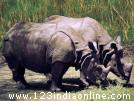 |
| Home Send Money to India Modes of money transfer India BPO India Tourism Taj Mahal Kumarakom Lakes Jaipur Pink city Alappuzha Backwaters Goa Tourism Munnar Hill Station India States Andhra Pradesh Assam Bihar Chattisgarh Goa Gujarat Haryana Himachal Pradesh Jammu and Kashmir Jharkhand Karnataka Kerala Madhya Pradesh Maharashtra Manipur Meghalaya Mizoram Nagaland Punjab Rajasthan Sikkim Tamil Nadu Orissa Tripura Uttar Pradesh Uttaranchal West Bengal India Quick Links Indiaweblinks World Wonders Web 123 Biotech Honeymoon Packages |
India States - Assam  Assam - the land where you find flowers that are exquisitely beautiful, animals that are rare, and a beleagured people that are proud and inviting. It is the land of the mighty river Brahmaputra (the Luit) and the one-horned rhinoceros.
Bihu is the national festival of Assam. The principal of the three Bihus, Bohag or Rongali Bihu ushers in the Assamese New Year, in the middle of April, and is celebrated with distinctive Bihu dances and songs.
Assam - the land where you find flowers that are exquisitely beautiful, animals that are rare, and a beleagured people that are proud and inviting. It is the land of the mighty river Brahmaputra (the Luit) and the one-horned rhinoceros.
Bihu is the national festival of Assam. The principal of the three Bihus, Bohag or Rongali Bihu ushers in the Assamese New Year, in the middle of April, and is celebrated with distinctive Bihu dances and songs.
 Assam, the land of hills and valleys, the land of the mighty river Brahmaputra, the land of Mother Goddess Kamakhya, lies in the northeastern corner of India. In these pages, you will find a few glimpses of Assam and Assamese people. Assam is a land of about 25 million people situated in the northeast corner of India. The principal language of Assam is Assamese although a large number of other languages are spoken. Assam comprises an area of 78,523 square kilometers (30,318 square miles). Except for a narrow corridor running through the foothills of the Himalayas that connects the state with West Bengal, Assam is almost entirely isolated from India. The capital of Assam, is Dispur, a suburb of Guwahati in 1972.
Assam, the land of hills and valleys, the land of the mighty river Brahmaputra, the land of Mother Goddess Kamakhya, lies in the northeastern corner of India. In these pages, you will find a few glimpses of Assam and Assamese people. Assam is a land of about 25 million people situated in the northeast corner of India. The principal language of Assam is Assamese although a large number of other languages are spoken. Assam comprises an area of 78,523 square kilometers (30,318 square miles). Except for a narrow corridor running through the foothills of the Himalayas that connects the state with West Bengal, Assam is almost entirely isolated from India. The capital of Assam, is Dispur, a suburb of Guwahati in 1972.
A Storied History  The name "Assam" is derived from the term "Asom" which, in Sanskrit, refers to unequal or unrivalled. The uneven topography of the land, full of hills, plains and rivers might, therefore, have contributed to her name. The Mongolian Ahom dynasty which had ruled Assam for more than six hundred years might also be the cause for her name
The name "Assam" is derived from the term "Asom" which, in Sanskrit, refers to unequal or unrivalled. The uneven topography of the land, full of hills, plains and rivers might, therefore, have contributed to her name. The Mongolian Ahom dynasty which had ruled Assam for more than six hundred years might also be the cause for her name
More History
 Assam is a land with an illustrious recorded history going back to the 4th century BC. Assam was an independent kingdom throughout all of history till the end of the first quarter of the 19th century when the British conquered the kingdom and annexed it to British India. The current state capital of Assam, Guwahati, known in ancient time as Pragjyotishpura or The Eastern City of Light, was the capital of Kamrup which finds frequent mention in the Great Hindu Epic Mahabharata and other Sanskrit volumes and historical lores
Assam is a land with an illustrious recorded history going back to the 4th century BC. Assam was an independent kingdom throughout all of history till the end of the first quarter of the 19th century when the British conquered the kingdom and annexed it to British India. The current state capital of Assam, Guwahati, known in ancient time as Pragjyotishpura or The Eastern City of Light, was the capital of Kamrup which finds frequent mention in the Great Hindu Epic Mahabharata and other Sanskrit volumes and historical lores |
|
|
|

